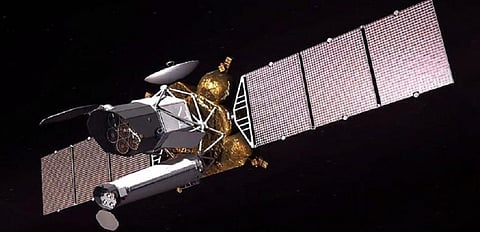

A joint team of German-Russian scientists is all set to launch next week a space telescope, which will create a three-dimensional (3D) X-ray map of the universe and unveil unknown supermassive black holes, dark energy and stars, the Nature reported.
The telescope, named Spectrum-Roentgen-Gamma (SRG), will be launched into space on a Russian-built Proton-M rocket from the Baikonur Cosmodrome in Kazakhstan on June 21, 2019.
The four-year mission will survey the entire sky eight times and track the evolution of the universe and dark energy — a mysterious repulsive force — that is accelerating its expansion.
Besides, it also aims to detect up to three million supermassive black holes — many of which are unknown — and X-rays from as many as 700,000 stars in the Milky Way. The telescope is the first to be sensitive to high-energy ‘hard’ X-rays and map the entire sky, the report said.
“Have you seen your body in X-rays? It looks completely different. We will do the same with the universe,” Rashid Sunyaev, a cosmologist at the Max Planck Institute for Astrophysics in Garching, Germany, said in a statement.
SRG will carry two independent X-ray telescopes:
Each of them cover X-ray bands stretching to relatively much higher energies: 0.2–10 kiloelectronvolts (keV) for eROSITA, and 5–30 keV for ART-XC.
The SRG will also find how dark matter — the main engine of galaxy formation — is spread in the universe.
“So far, the dark-matter explanation is still on the table” as a potential cause of the X-ray signal, said Esra Bulbul, an astrophysicist at the Max Planck Institute for Extraterrestrial Physics and a lead scientist on the mission.
The SRG will, however, not detect gamma radiation, the report stated.
X-ray sky surveys have also been conducted by previous missions, but they were not able to map the entire sky, the report said.
While Germany's ROSAT mission in the 1990s was sensitive only to ‘soft’ X-rays, with energies of about 2 keV, existing missions, such as NASA’s Chandra X-ray Observatory and NuSTAR, can see high-energy radiation and resolve tiny details of cosmic structures. But, they see only small parts of the sky.
SRG was first proposed in 1987, by Russian astrophysicists, but the fall of Soviet Union in 1991 led to the plans' cancellation.
It was again revived in 2004, but a proposal to send an X-ray telescope to the International Space Station was scrapped when NASA ended its space-shuttle programme in 2011. Finally, the joint mission was approved by the German space agency and Roscosmos later in 2009.